Right outside our guesthouse this morning is the ‘most photographed mountain in Iceland’ – Kirkjufell. Kirkjufell is 463m high and located on the north coast of the Snæfellsnes peninsula, near the town of Grundarfjörður.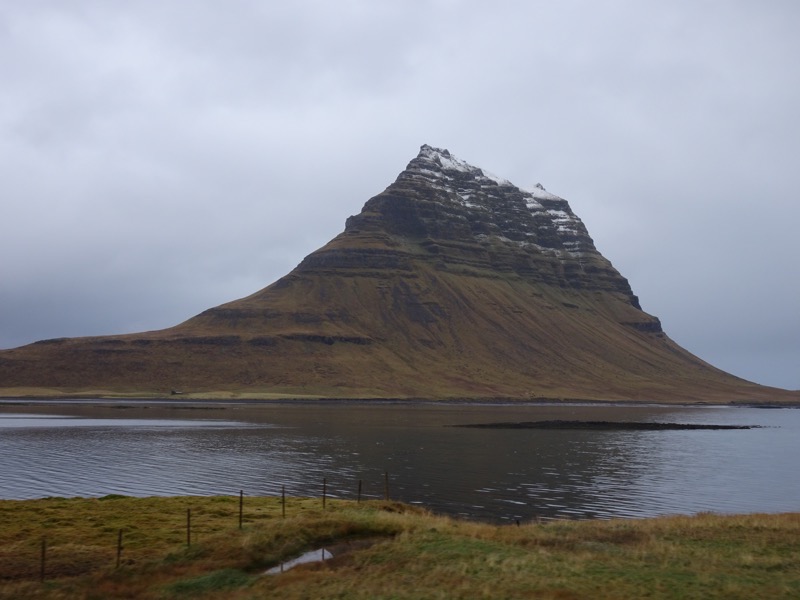 And this tiny looking waterfall, Grundarfoss, is probably a big part of that claim to fame…
And this tiny looking waterfall, Grundarfoss, is probably a big part of that claim to fame…
 Because when viewed from a certain angle these two landmarks are literally ‘postcard Iceland’. This image and this view can be seen on postcards everywhere… well maybe not looking like this, all overcast and moody but you Google image serach ‘Kirkjufell, ‘ you get the idea.
Because when viewed from a certain angle these two landmarks are literally ‘postcard Iceland’. This image and this view can be seen on postcards everywhere… well maybe not looking like this, all overcast and moody but you Google image serach ‘Kirkjufell, ‘ you get the idea.
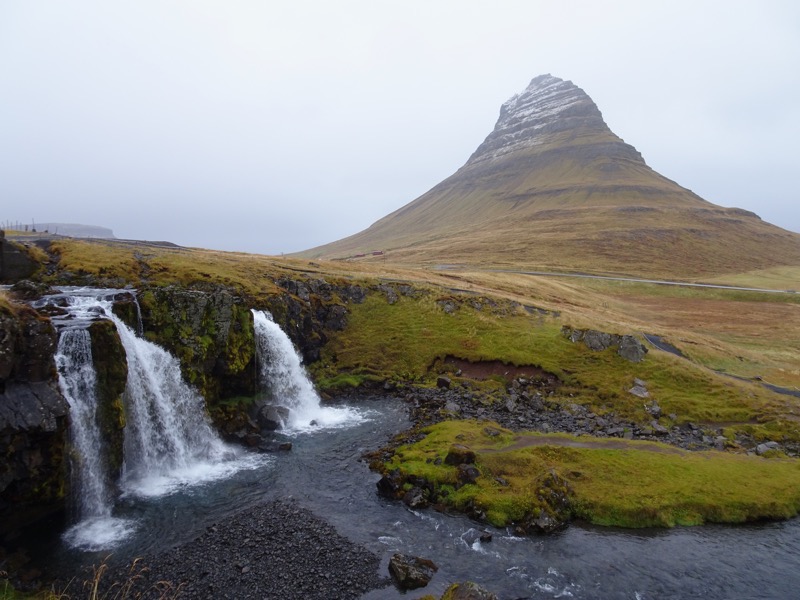 Getting a starring role in Game of Thrones probably also helped with the whole, ‘most photographed’ title; Kirkjufell featured as the “Arrowhead Mountain” that the Hound and the company north of the Wall see when capturing a wight in seasons 6 and 7.
Getting a starring role in Game of Thrones probably also helped with the whole, ‘most photographed’ title; Kirkjufell featured as the “Arrowhead Mountain” that the Hound and the company north of the Wall see when capturing a wight in seasons 6 and 7.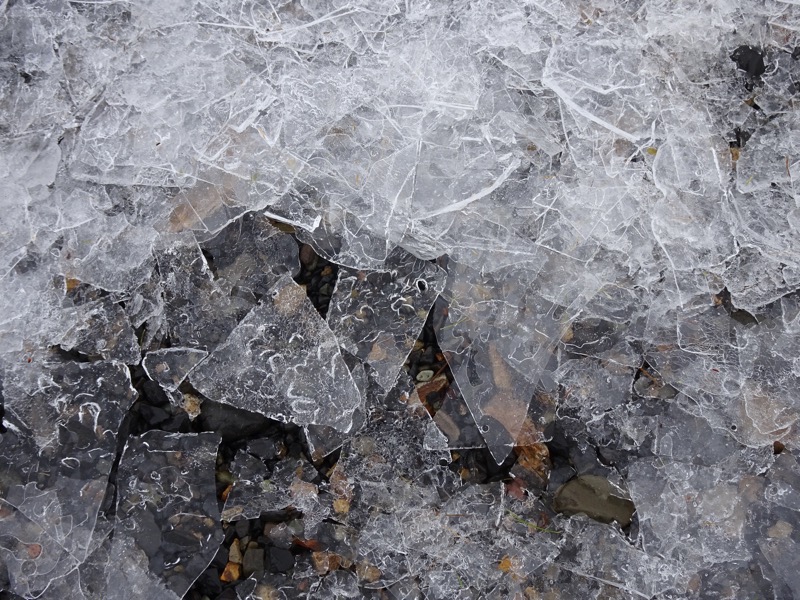
Today took us around the Snæfellsnes peninsula which is famous for its gorgeous scenery. It was looking a bit dismal when we set out – but one thing we have learned here, is that there is always a completely different view around the corner… and sometimes completely different weather too.
 Olafsvikurkirkja – one of the more unusual churches we have seen here. Traditionally churches appear to be white buildings with red rooves, but this 1967 modern design is unique compared to most others we have seen. There are so many churches dotted around the landscape that it sometimes feels a bit, ‘Oh there are three farms meeting in one place; we need a church’.
Olafsvikurkirkja – one of the more unusual churches we have seen here. Traditionally churches appear to be white buildings with red rooves, but this 1967 modern design is unique compared to most others we have seen. There are so many churches dotted around the landscape that it sometimes feels a bit, ‘Oh there are three farms meeting in one place; we need a church’.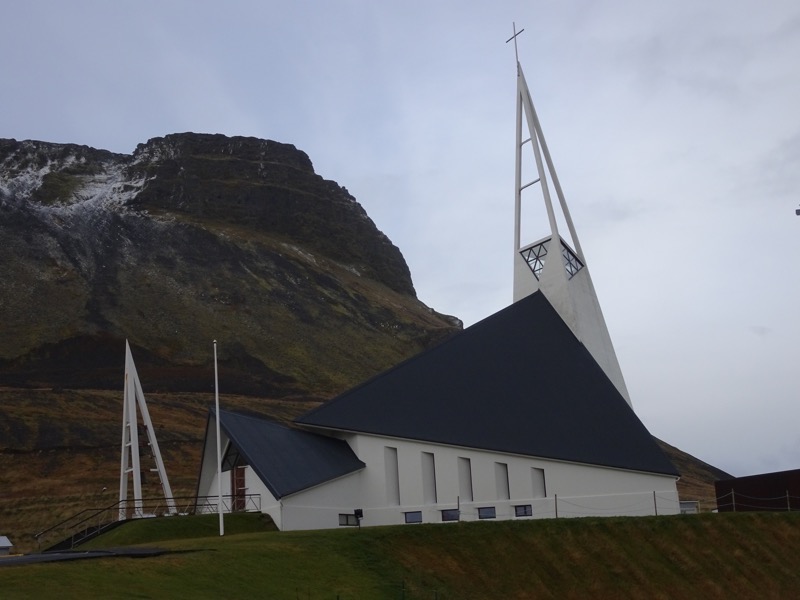 Svöðufoss. There are so many waterfalls in Iceland that they are starting to feel like ancient ruins on a trip through the Mediterranean…
Svöðufoss. There are so many waterfalls in Iceland that they are starting to feel like ancient ruins on a trip through the Mediterranean…

The welcome into the town of Hellissandur A Hellisunder local, Kári Viðarsson who grew up and lives in the town started a street art project painting this local fish factory… we even spied some murals on some residential homes.
A Hellisunder local, Kári Viðarsson who grew up and lives in the town started a street art project painting this local fish factory… we even spied some murals on some residential homes.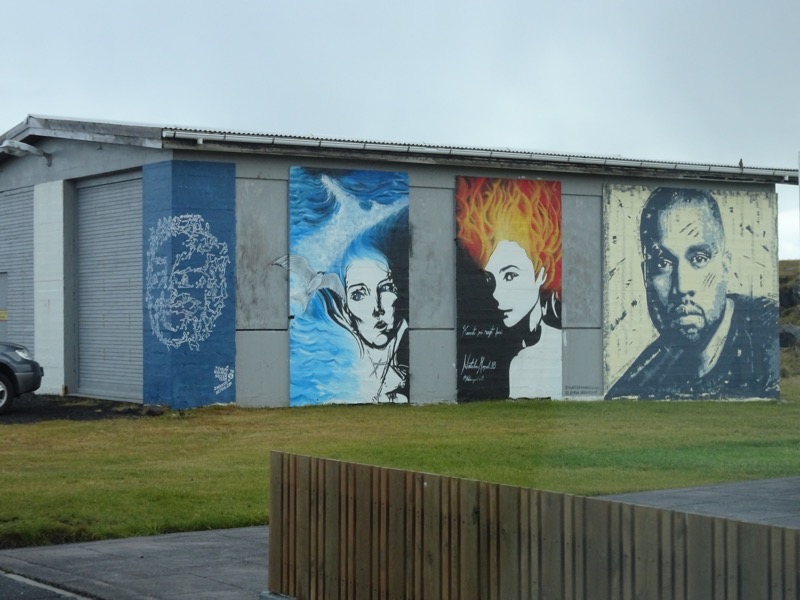 Now the project has taken on a world of its own and he has murals on many local buildings including the local hostel. The eventual plan is to have a mural on at least one wall of every building in town.
Now the project has taken on a world of its own and he has murals on many local buildings including the local hostel. The eventual plan is to have a mural on at least one wall of every building in town. 

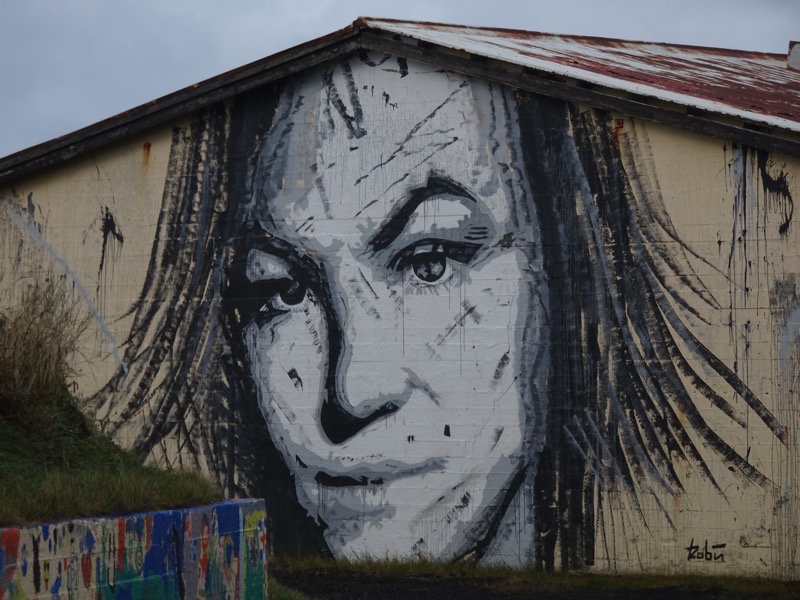
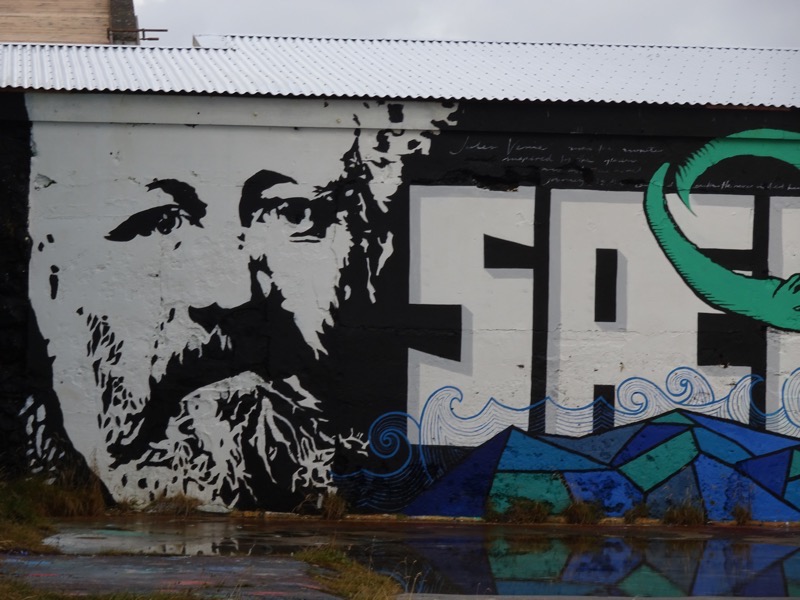
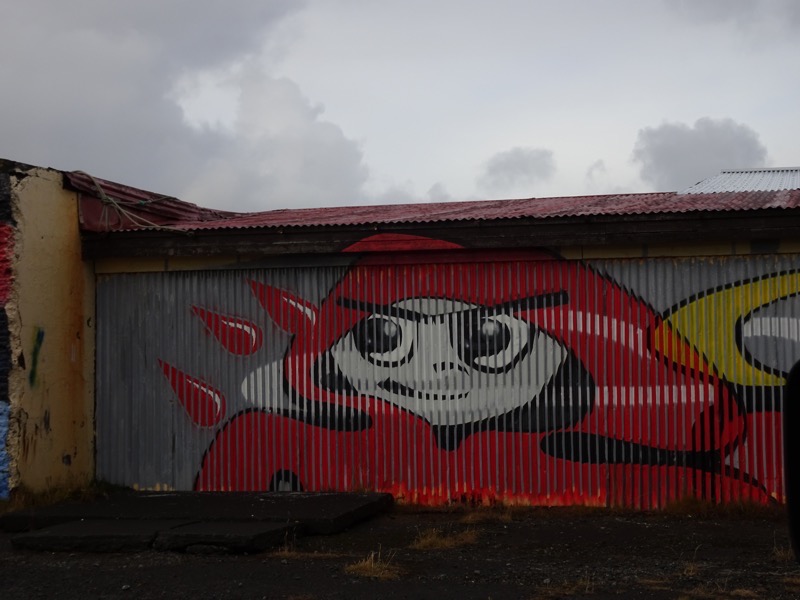

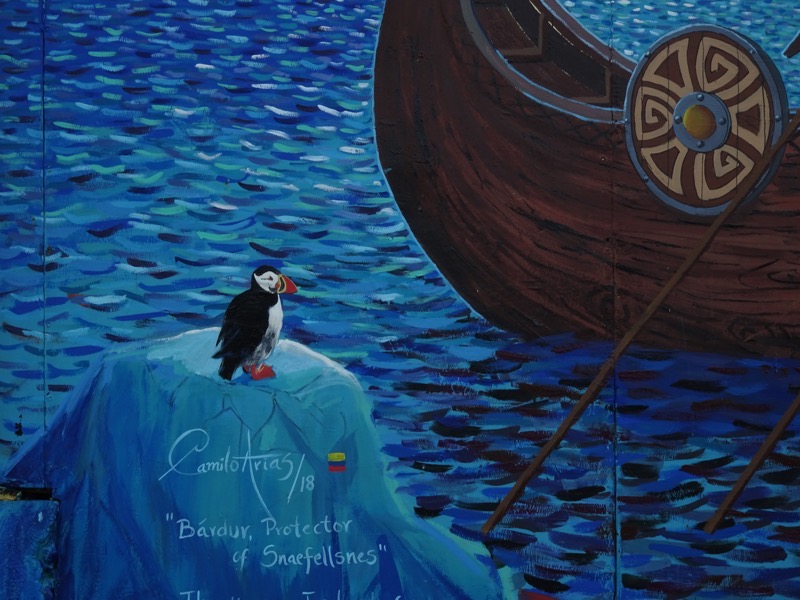
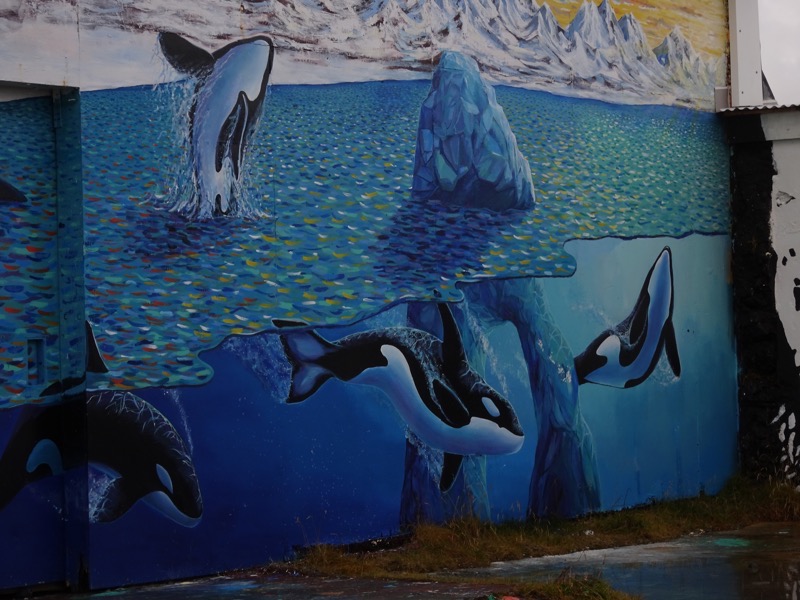
Further down the road, we found ourselves driving through some now familiar but still dramatic lava fields to get to Djúpalónssandur beach.
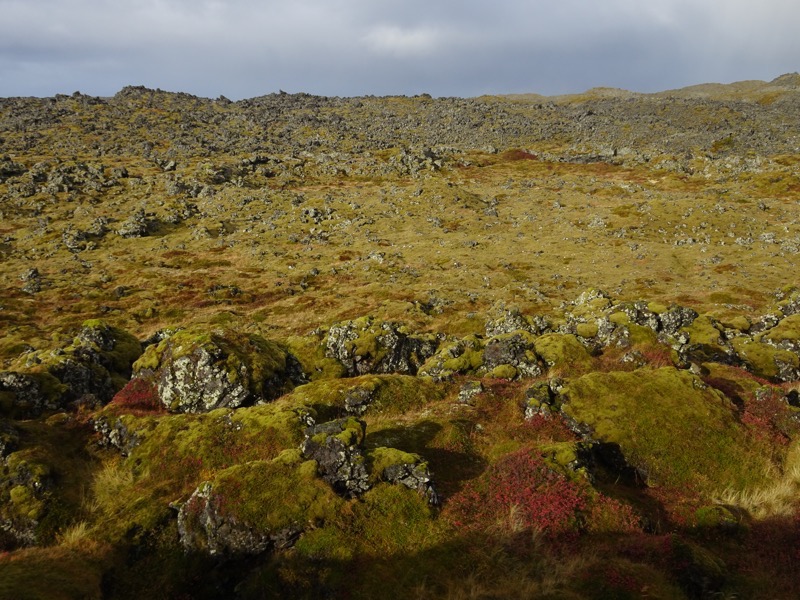
Djúpalónssandur is a sandy beach at the base of Snæfellsjökull (the glacier on the Snaefellsnes peninsular). There used to be a thriving fishing village here with up to sixty fishing boats but today the bay is uninhabited and there is no sign of the old village.
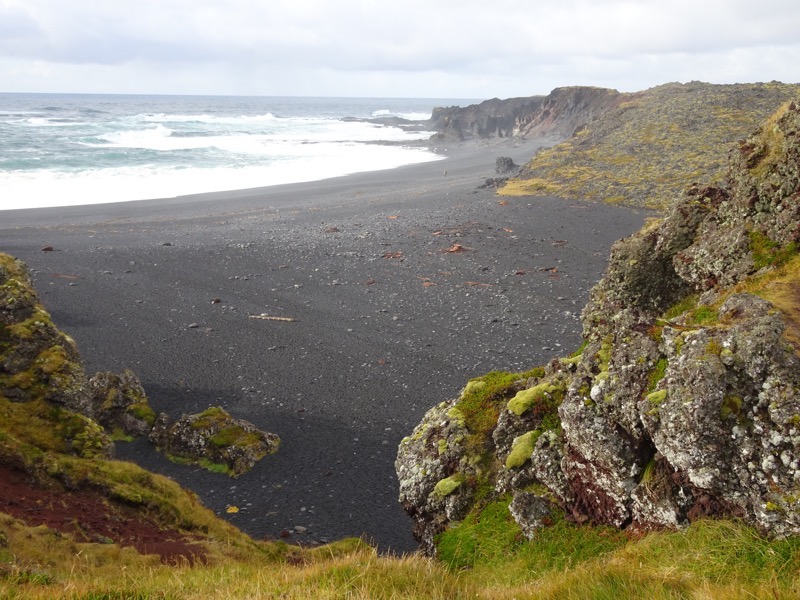
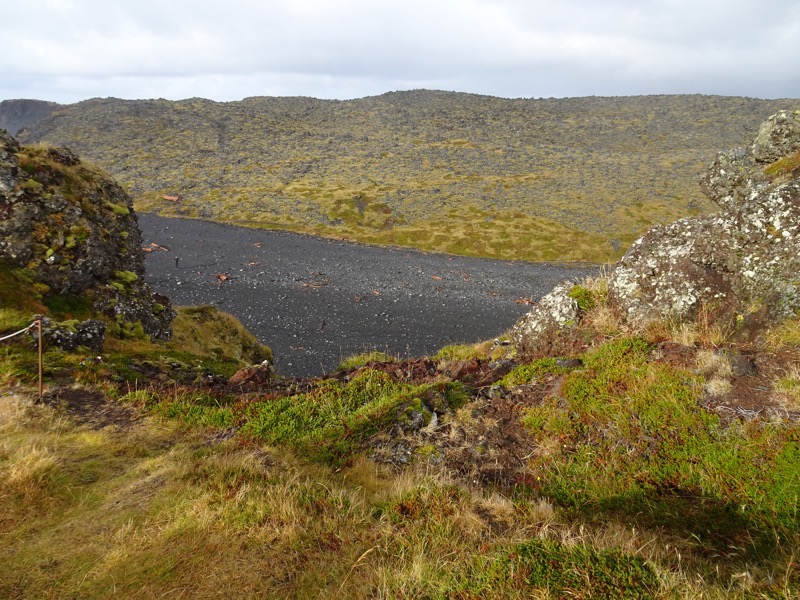 On the beach, there are the scattered steel remains of the Grimsby – a British fishing trawler that was wrecked here in 1948.
On the beach, there are the scattered steel remains of the Grimsby – a British fishing trawler that was wrecked here in 1948.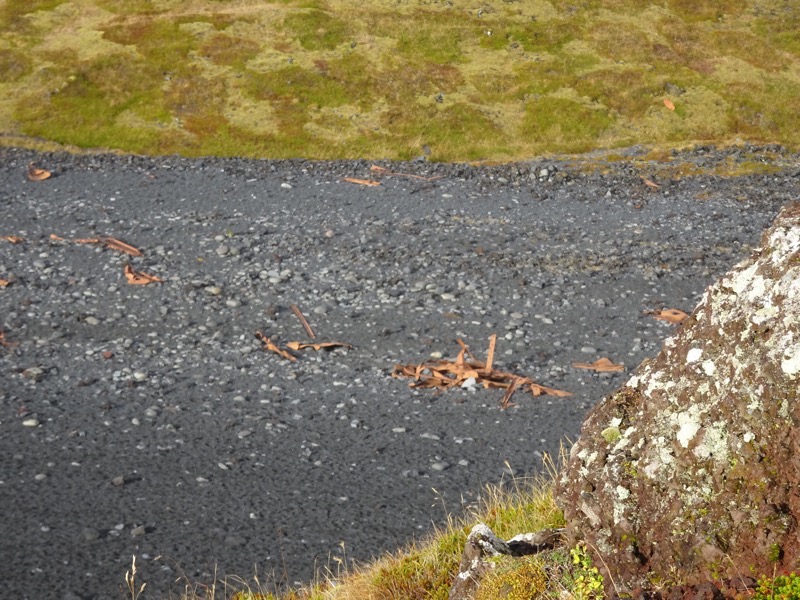
Djúpalónssandur is also known for its four ‘lifting stones’ which were used by the fishermen to test their strength.
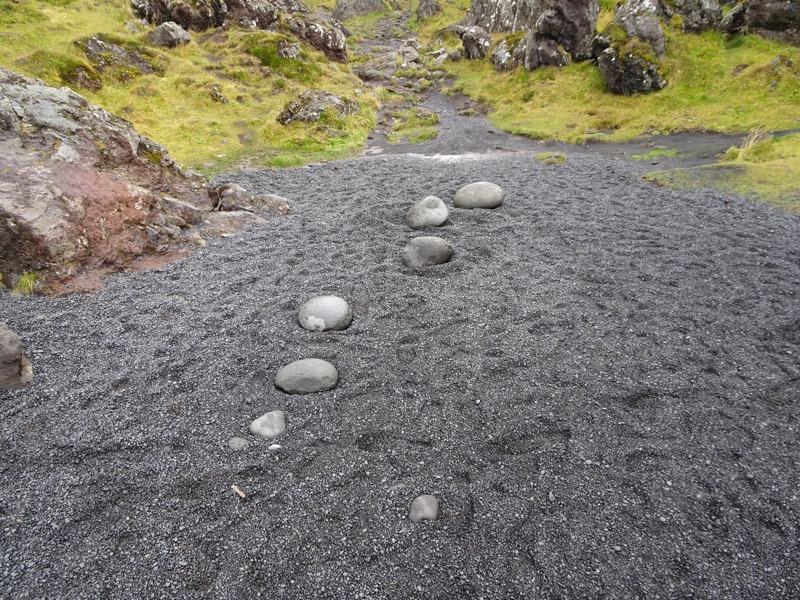

They are Fullsterkur (“full strength”) weighing 154 kg, Hálfsterkur (“half strength”) at 100 kg, hálfdrættingur (“weakling”) at 54 kg and Amlóði (“Useless”) 23 kg. Traditionally the stones were used to decide if men were strong enough to qualify men to work on fishing boats, A would-be fisherman would have to be able to lift the Hálfdrættingur onto a ledge at hip-height to get a job. yale took these pictures and had a go at lifting them… he managed to lift the ‘weakling’ stone, so maybe he could have got a job as an oarsman. 😀
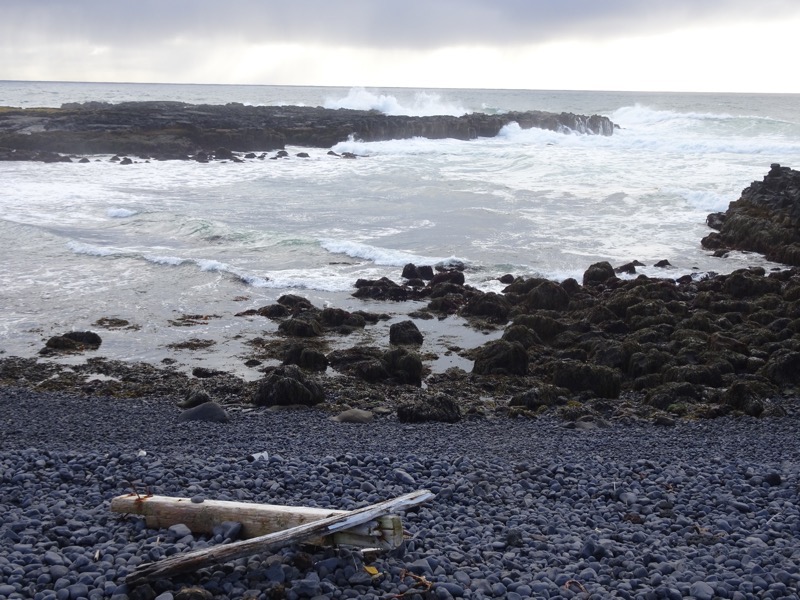
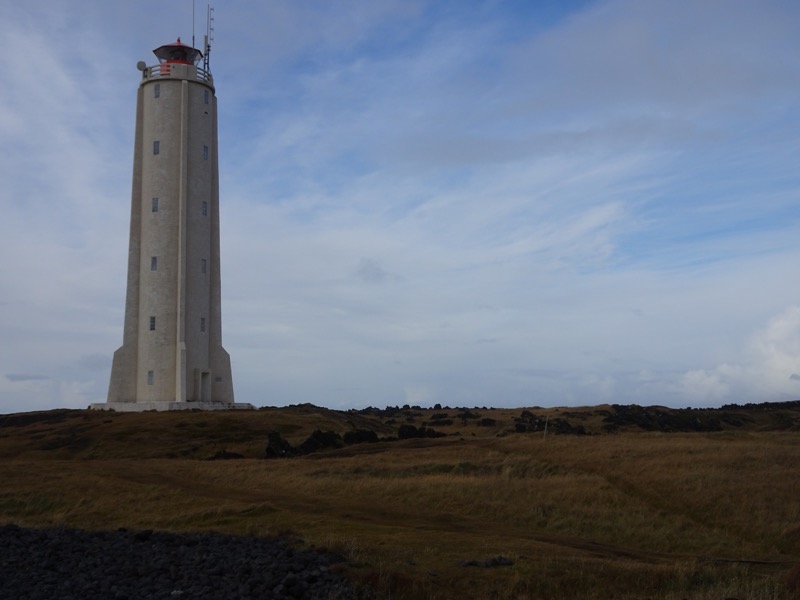 We stayed for quite a while watching the rain roll in, as the waves crashed over the craggy black lava rocks. The power of the surf hitting rocks like this is always impressive. This is the first place that I *didn’t* suggest that yale take a swim…
We stayed for quite a while watching the rain roll in, as the waves crashed over the craggy black lava rocks. The power of the surf hitting rocks like this is always impressive. This is the first place that I *didn’t* suggest that yale take a swim…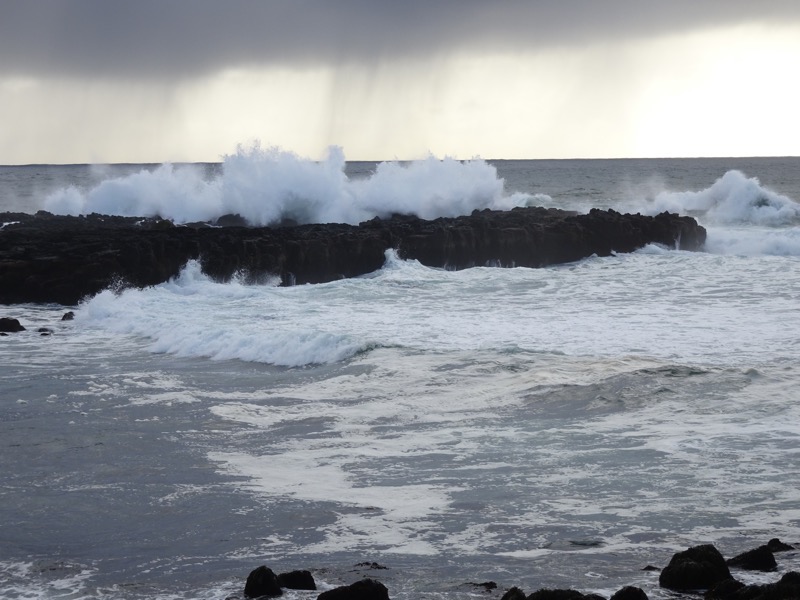
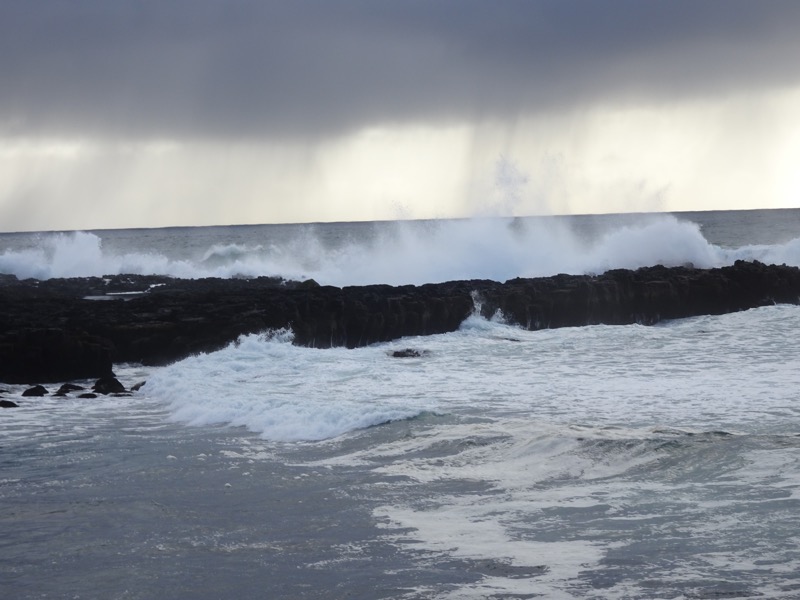
We left our Jeep at the visitor’s centre when we went to go for a walk to the lighthouse, but someone turned it into a Matchbox Car by the time we got back…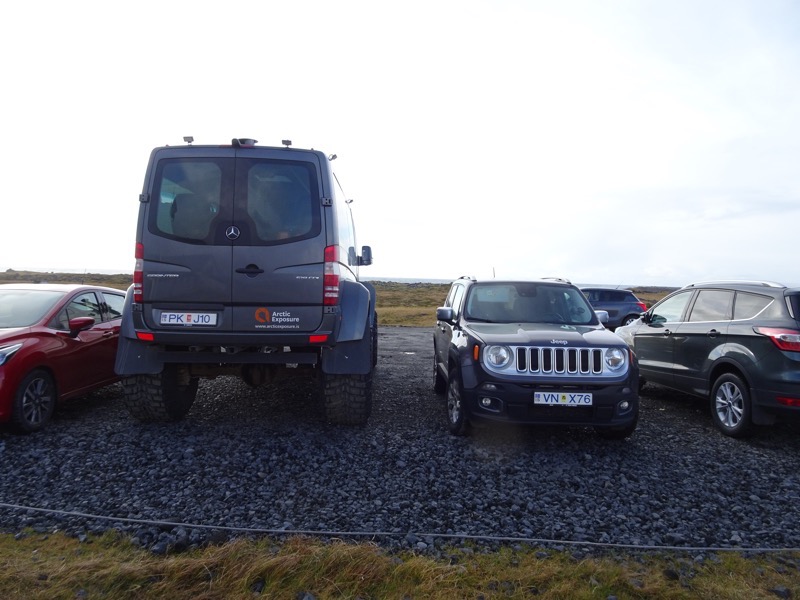 Again, as we drive around, everywhere we look is simply stunning scenery – I have so many photos taken out the car window from discovering more pretty sights around every corner.
Again, as we drive around, everywhere we look is simply stunning scenery – I have so many photos taken out the car window from discovering more pretty sights around every corner.
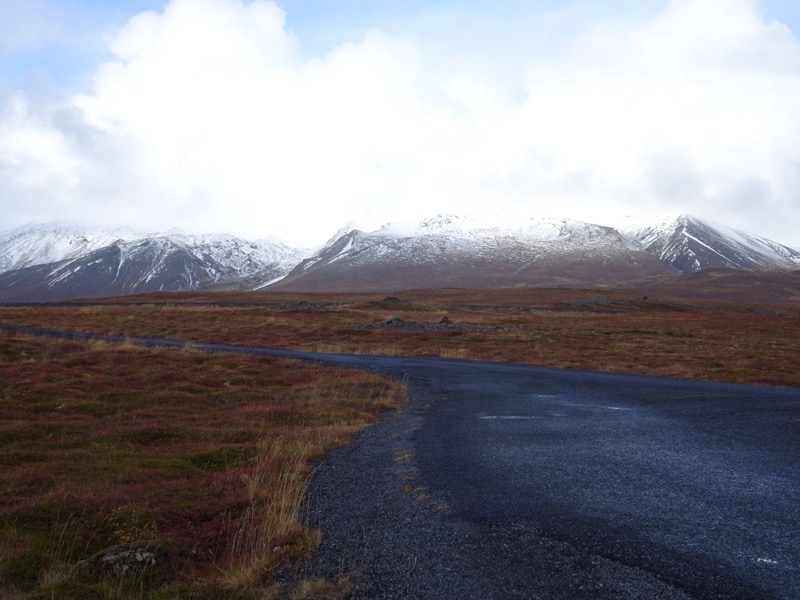
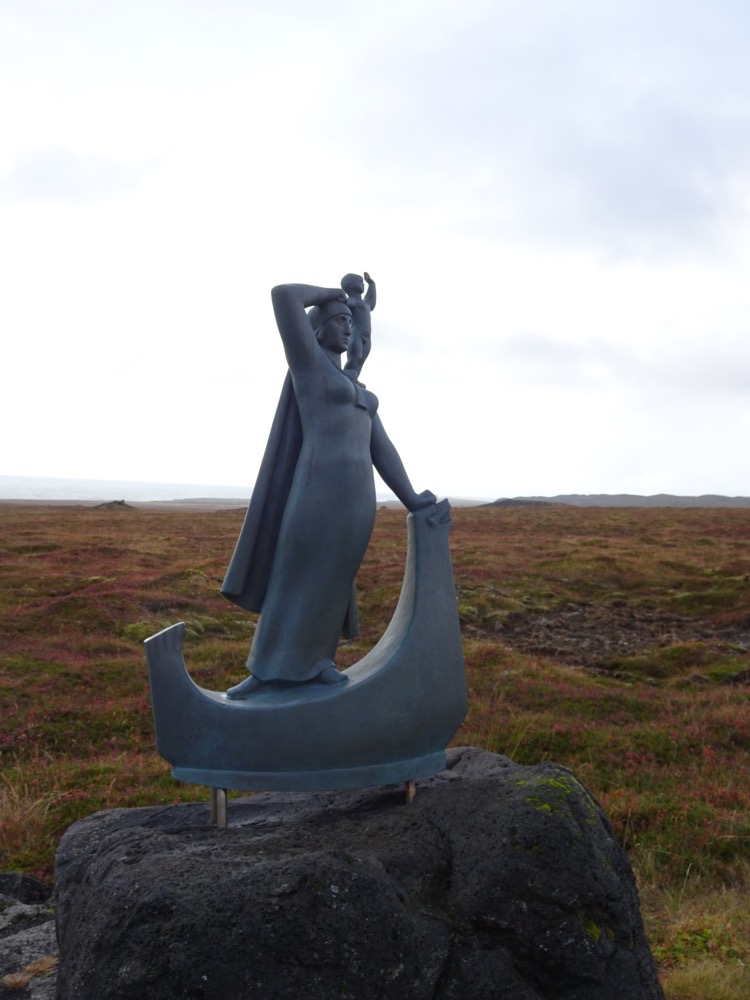
This is a monument to Guðríður Thorbjarnardótti who was orn at Laugarbrekka in Snæfellsnes. Guðríður appears in the Saga of ERik the Red and also in the Saga of the Greenlanders which combined make up the Vinland sagas. She and her husband, Þorfinnur Karlsefni, led expeditions to Vinland,
She appears in the Saga of Erik the Red and the Saga of the Greenlanders, known collectively as the Vinland Sagas. She and her husband Þorfinnur Karlsefni led an expedition to Vinland (which is what the Norsemen called, areas of North America that they explored in approximated 1000AD). Their son, Snorri Þorfinnsson is believed to be the first European birth in the Americas.
She became a bit of an early explorer taking many voyages.
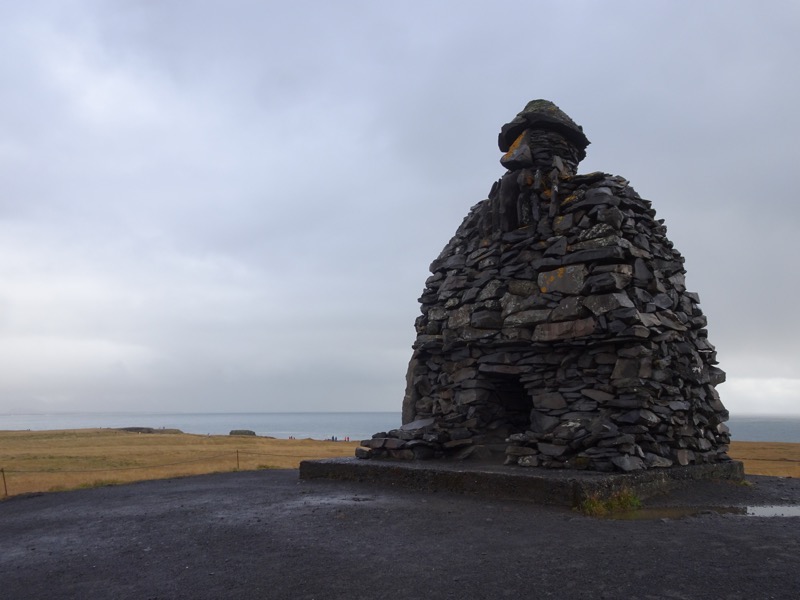 Bárðr Snæfellsnes is another character from Icelandic sagas; Bárðr’s mother was human, but his father was half giant and half troll. Growing up, he lived with Dofri, the “mountain-dweller” of Dovrefjell (in central Norway). He had three tall beautiful daughters with his first wife, Flaumgerðr (who had a human mother but was also Dofri the mountain dweller’s daughter): Helga, Þordís and Guðrún. With his second wife, Herþrúðr, who was human, he had six more daughters.
Bárðr Snæfellsnes is another character from Icelandic sagas; Bárðr’s mother was human, but his father was half giant and half troll. Growing up, he lived with Dofri, the “mountain-dweller” of Dovrefjell (in central Norway). He had three tall beautiful daughters with his first wife, Flaumgerðr (who had a human mother but was also Dofri the mountain dweller’s daughter): Helga, Þordís and Guðrún. With his second wife, Herþrúðr, who was human, he had six more daughters.
Bárðr and his family emigrated to Iceland at Snæfellsnes which they named Djúpalón and he built himself a farm which he called Laugarbrekka. Bárðr’s also had a half-brother, Þorkell, from his human mother’s second marriage, and Þorkell lived at Arnarstapi with his two sons, Rauðfeldr (Red-cloak) and Sölvi, who we will get to shortly…
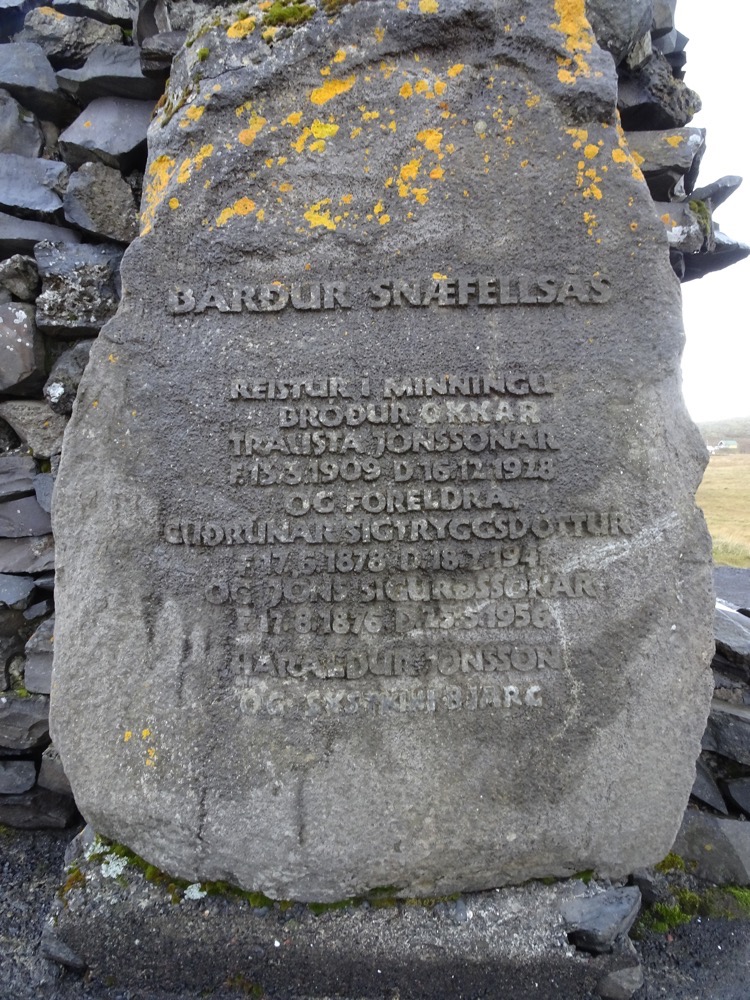
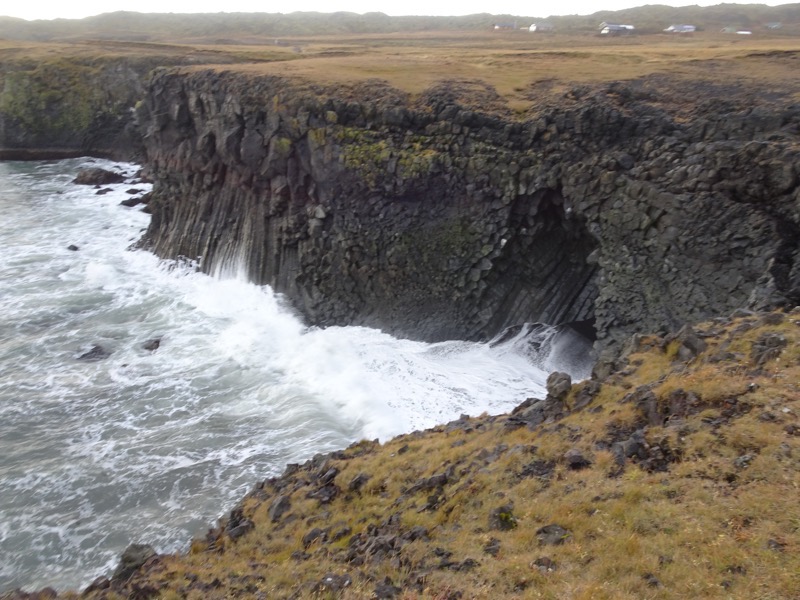 The peninsula here with its amazingly tall basalt columns and natural arches is breathtaking.
The peninsula here with its amazingly tall basalt columns and natural arches is breathtaking. 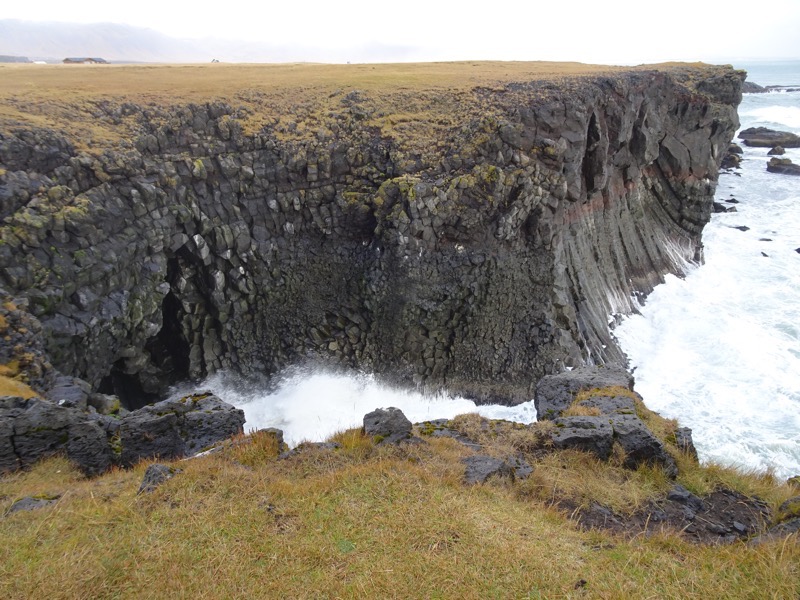
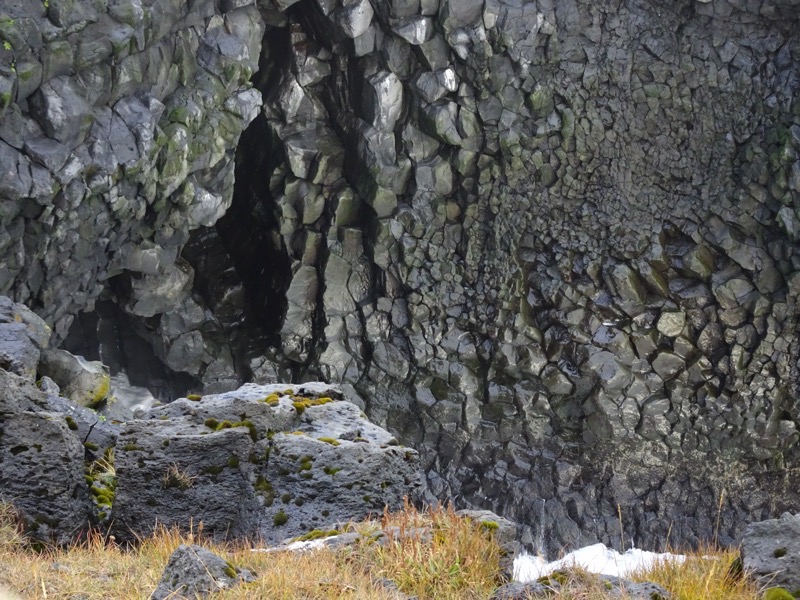
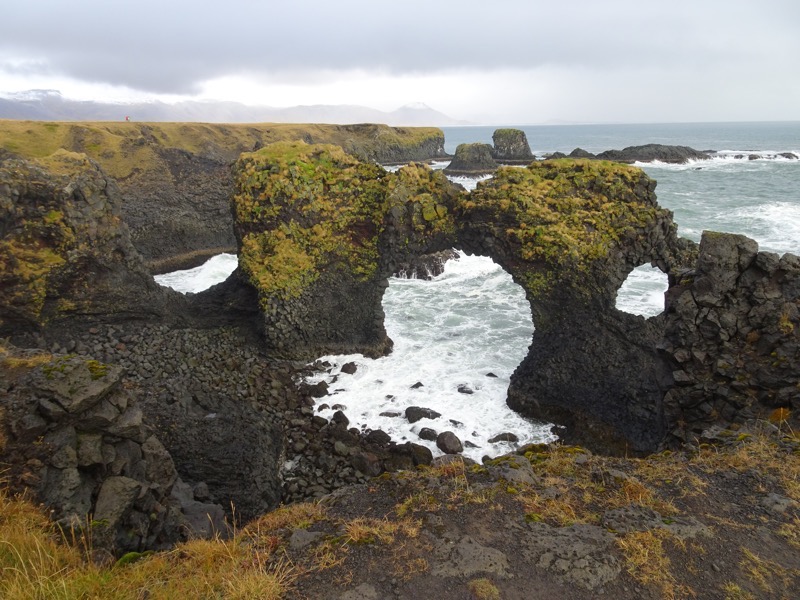
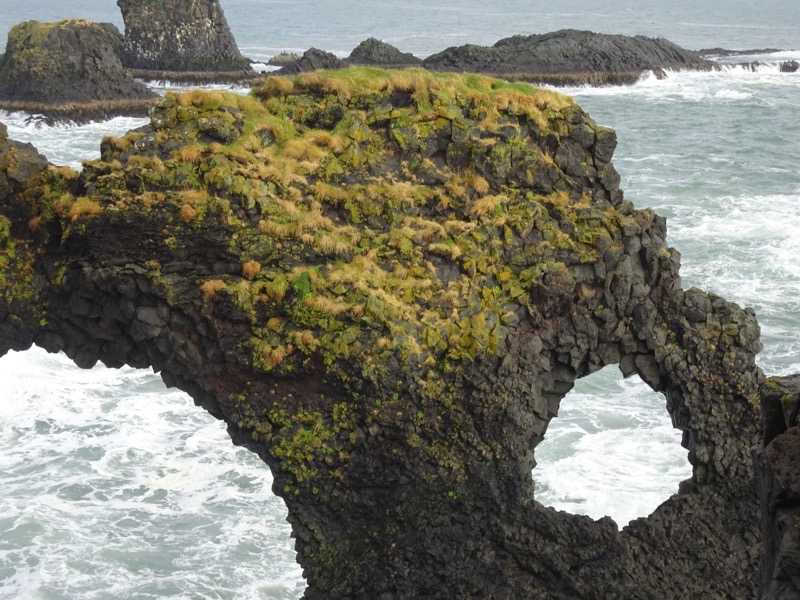 Anyway, back to Bárðr and Þorkell and their children. The sons of Þorkell and the daughters of Bárðr used to play together, as cousins do. However, one day, when there was pack ice along the shoreline, the sons of Þorkell, Rauðfeldr and Sölvi pushed Helga out to sea on an iceberg thinking she would drift for a while and come back. Unfortunately, she drifted out to sea, and unbeknownst to Bárðr, she drifted unharmed the 300 nautical miles to Greenland, where she ended up finding a lover and settling down. Bárðr, of course, thought she was dead and was infuriated. He pushed Rauðfeldr off the Rauðfeldsgjá, the high ravine at Arnarstapi and he threw Sölvi off a high cliff on the coast east called Sölvahamar. Þorkell was then infuriated too, and he and Bárðr fought until Þorkell ended up with a broken leg and moved out of the district.
Anyway, back to Bárðr and Þorkell and their children. The sons of Þorkell and the daughters of Bárðr used to play together, as cousins do. However, one day, when there was pack ice along the shoreline, the sons of Þorkell, Rauðfeldr and Sölvi pushed Helga out to sea on an iceberg thinking she would drift for a while and come back. Unfortunately, she drifted out to sea, and unbeknownst to Bárðr, she drifted unharmed the 300 nautical miles to Greenland, where she ended up finding a lover and settling down. Bárðr, of course, thought she was dead and was infuriated. He pushed Rauðfeldr off the Rauðfeldsgjá, the high ravine at Arnarstapi and he threw Sölvi off a high cliff on the coast east called Sölvahamar. Þorkell was then infuriated too, and he and Bárðr fought until Þorkell ended up with a broken leg and moved out of the district.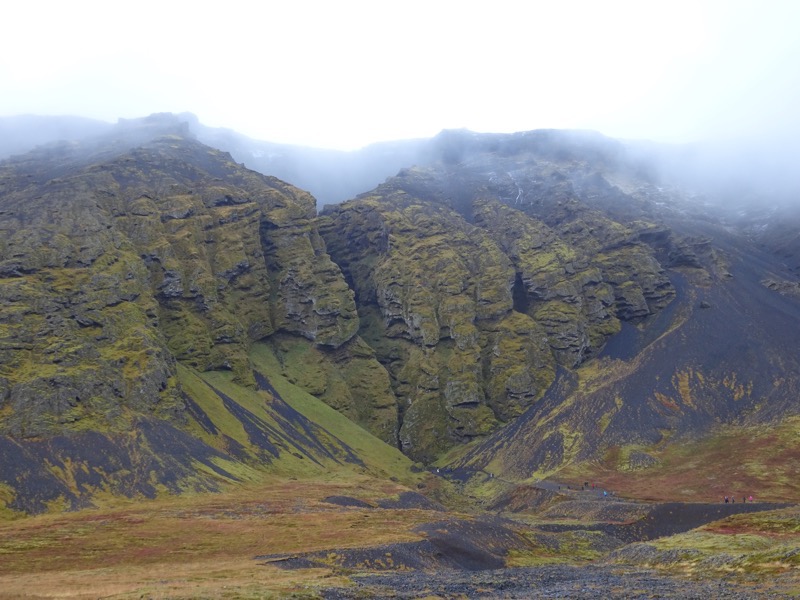 Rauðfeldsgjá ravine appears to be just a crack in the cliffline, but it is quite a long and steep chasm.
Rauðfeldsgjá ravine appears to be just a crack in the cliffline, but it is quite a long and steep chasm. 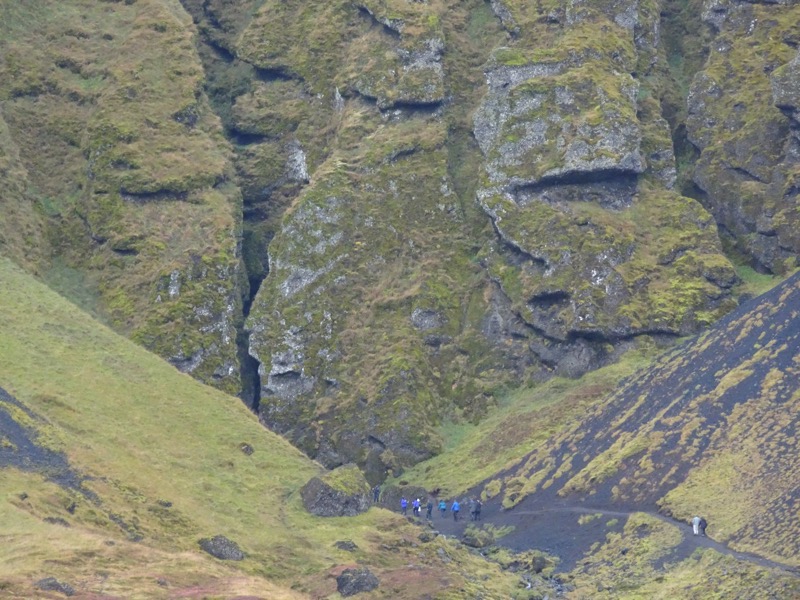
More beautiful scenery appeared as we were founding the southern side of the peninsula – rainbows, mirror like lakes, snowcapped mountains and rolling green hillsides.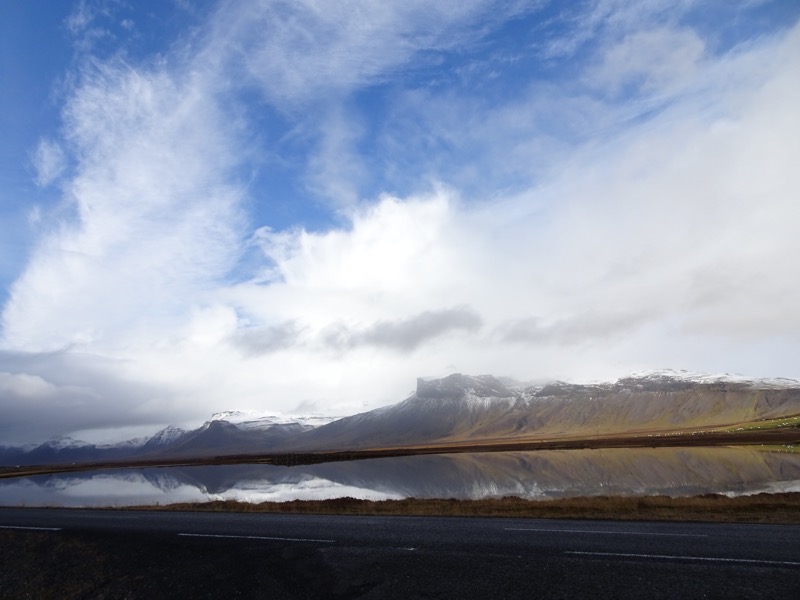

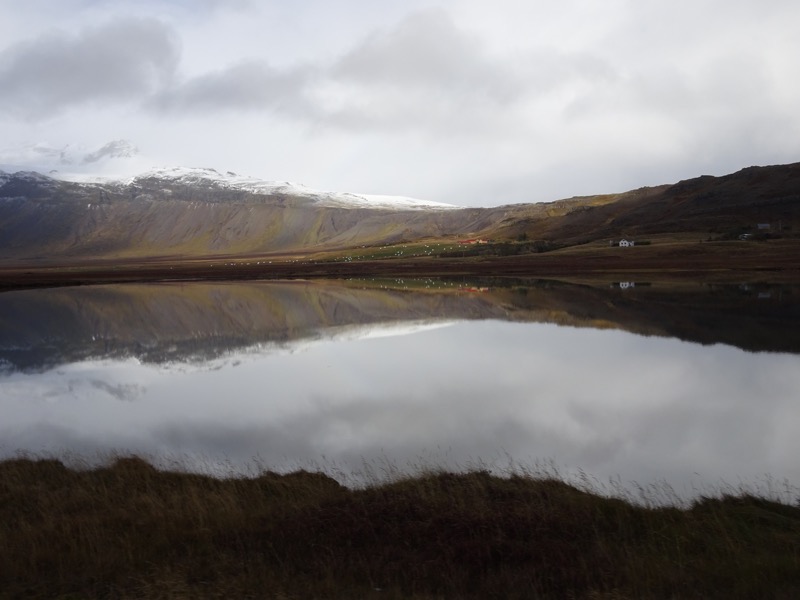 This is a reflection in the lake! (below)
This is a reflection in the lake! (below)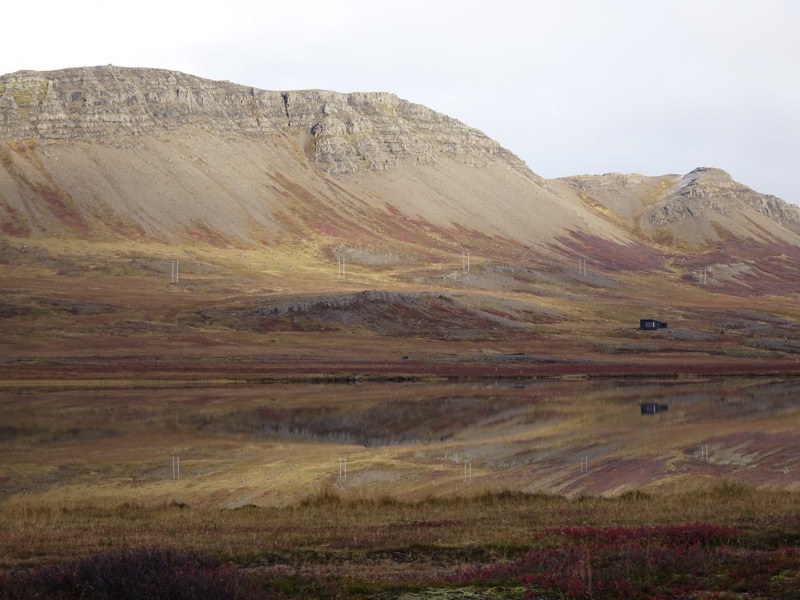
 We weren’t the only ones stopping to take photos… we were (mostly) the only ones taking photos of the scenery. yale doing his best Chinese tourist impression and posing in the now way too familiar, and no doubt already Chinese-Instagram-Famous, Airing The Vagina Pose…! We don’t know why they do it, but they are always standing around on one leg like this with their arms spread out in front of things?!?
We weren’t the only ones stopping to take photos… we were (mostly) the only ones taking photos of the scenery. yale doing his best Chinese tourist impression and posing in the now way too familiar, and no doubt already Chinese-Instagram-Famous, Airing The Vagina Pose…! We don’t know why they do it, but they are always standing around on one leg like this with their arms spread out in front of things?!?
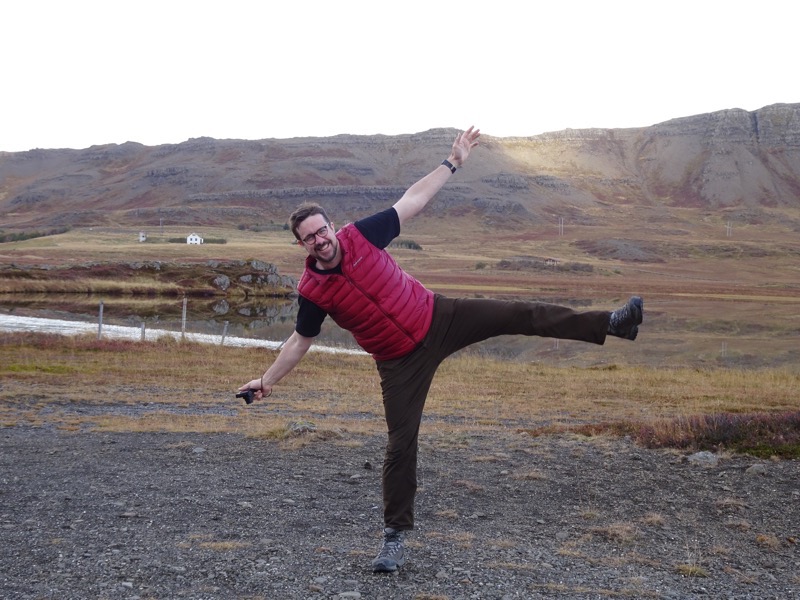 Hitting the road to Borgagnes…
Hitting the road to Borgagnes…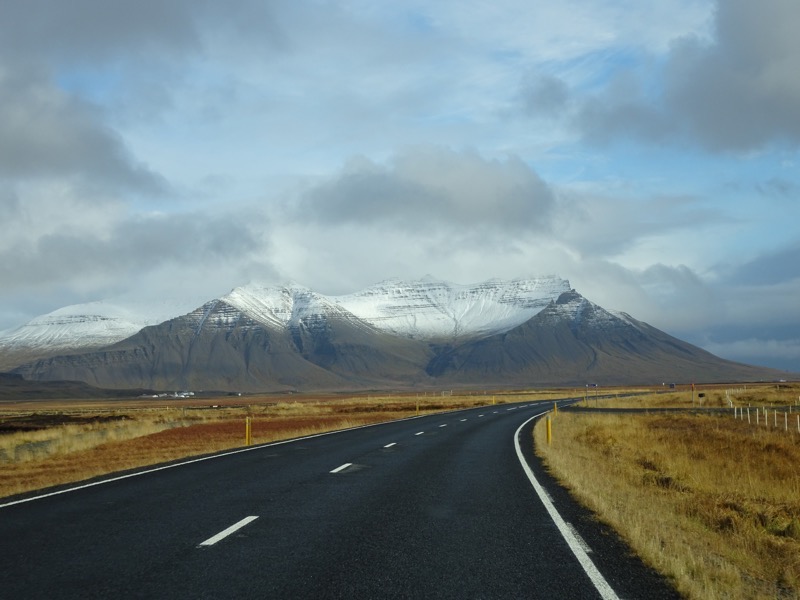
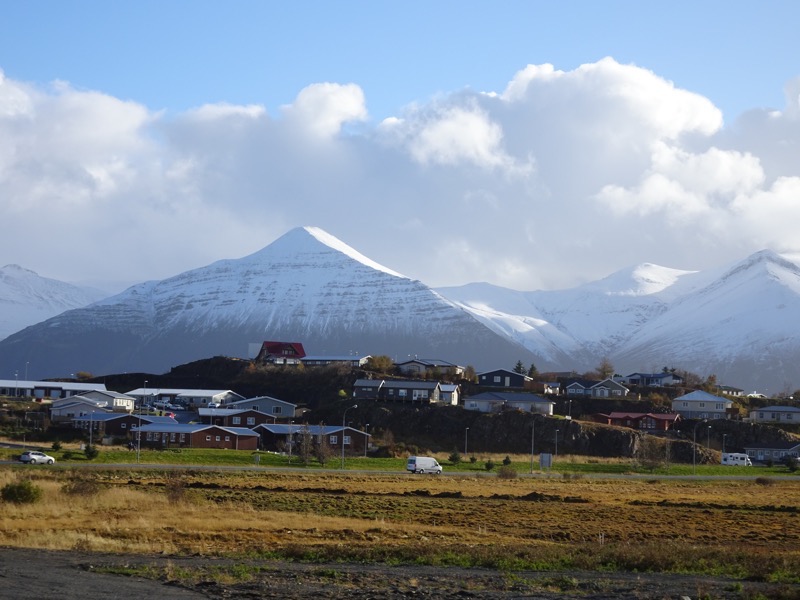
At Borganes we deliberately made a decision to drop a few IQ points and go to the Settlement Centre, where we were spoonfed some Icelandic sagas in easy tourist sized chunks with a handy audio tour and interactive displays. Personally, I fucking hate audio tours – they disconnect you from experience and your fellow traveller and put people in an even more self-centered bubble of not paying attention to those around them… but it is what it is, I guess.
 The top half of the audio tour was about the seafaring voyages of the viking eras… where they went how and a little bit of the who. I am hoping to get more solid/academically presented information on all this at the National Museum in a couple of days but it was interesting enough.
The top half of the audio tour was about the seafaring voyages of the viking eras… where they went how and a little bit of the who. I am hoping to get more solid/academically presented information on all this at the National Museum in a couple of days but it was interesting enough.

 The bottom half of the Settlement Centre’s display is an artistic representation of what is called Egill’s Saga. Egill Skallagrímsson was a Viking warrior and poet, whose story is told here through a wide range of art pieces in varying styles, by many artists, in a diverse array of media. I very much enjoyed the artworks – though it seems Egill was a bit of an arsehole.
The bottom half of the Settlement Centre’s display is an artistic representation of what is called Egill’s Saga. Egill Skallagrímsson was a Viking warrior and poet, whose story is told here through a wide range of art pieces in varying styles, by many artists, in a diverse array of media. I very much enjoyed the artworks – though it seems Egill was a bit of an arsehole. Wood carvings of the gods, Floki and Odin.
Wood carvings of the gods, Floki and Odin. Egill’s father, who was a very harsh man.
Egill’s father, who was a very harsh man.  A representation of Egill’s first killing at age seven, when he became enraged in an ice game (a precursor to modern ice hockey perhaps) and took an axe and killed a man.
A representation of Egill’s first killing at age seven, when he became enraged in an ice game (a precursor to modern ice hockey perhaps) and took an axe and killed a man. An artwork showing his parents reaction to the killing – Mum: You good warrior you, one day we will buy you a ship. Dad: Bad boy. You shouldn’t kill people. (Shortest version of that anyone ever wrote)
An artwork showing his parents reaction to the killing – Mum: You good warrior you, one day we will buy you a ship. Dad: Bad boy. You shouldn’t kill people. (Shortest version of that anyone ever wrote)
 Egill’s fantastically handsome brother who look nothing like his father… mentioned repeatedly.
Egill’s fantastically handsome brother who look nothing like his father… mentioned repeatedly. A scorn pole made to curse Egill by someone else he had crossed.
A scorn pole made to curse Egill by someone else he had crossed. An artwork representing some magic and shamanism.
An artwork representing some magic and shamanism.
 Egill in his melancholy after losing his two sons.
Egill in his melancholy after losing his two sons.
The Settlement Centre was interesting enough – if you have no actual interest in dark ages history and don’t mind being treated like a school kid. I am glad the place was empty when we were there – or I think I would have left.
After this, we went to find our guesthouse, Hotel Hafnarfjall and ferret out some dinner. We checked in and I was disappointed to see we had been allocated a room looking towards the mountain and not over the fjord. Not that it wasn’t a very pretty snow-capped mountain behind us, but we were finally expecting a really high probability of an opportunity to see the northern lights tonight, and it would have been better to have a more open view. No sooner had we walked into the room when the owner came around to get us, walked into the bathroom and tut-tutted about the ventilation fan not working and he moved us to a fjord view room! Sweet. 😀
So, the aurora forecast, that I have been watching like a hawk since we got here was finally showing levels of 4 and 5 over most of Iceland… it had been hovering around 2-3 for most of our visit. But the bigger problem was that with all the snow, rain and overcast weather we were having – even if it had been peaking, we were unlikely to see it wherever we were due to the dense cloud cover.

Well tonight, we were near those three sunny patches on the left-hand side of the country… so I had high hopes we would see at least a little something. yale just made me a supercool .gif of all the screen grabs I have been taking as I watched the forecast today!
 And just after dinner we went for a little drive away from the city lights and managed to spot the aurora peeking out between the clouds.
And just after dinner we went for a little drive away from the city lights and managed to spot the aurora peeking out between the clouds.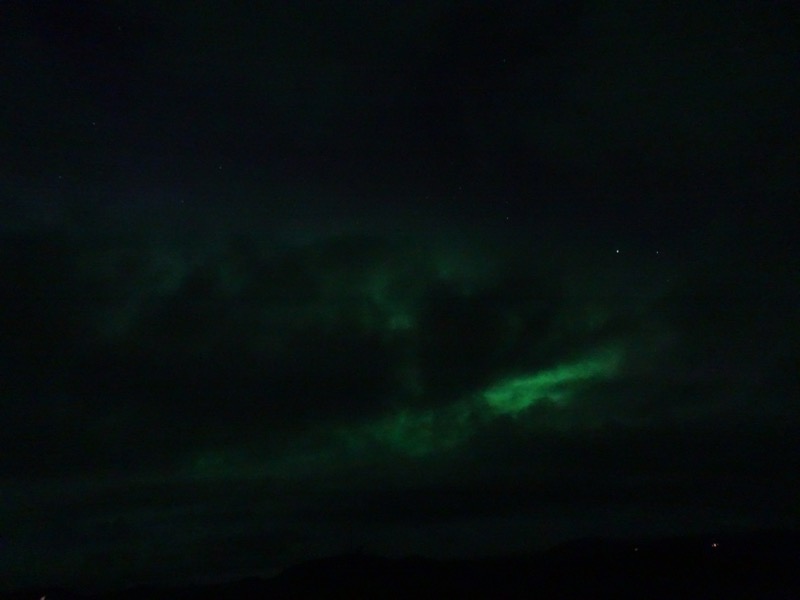 It’s a stunning phenomena, and very hard to capture with a handheld camera and no tripod! 😛 Yeah, well equipped photographer I am. We drove around a bit chasing the brightest green in the sky.
It’s a stunning phenomena, and very hard to capture with a handheld camera and no tripod! 😛 Yeah, well equipped photographer I am. We drove around a bit chasing the brightest green in the sky.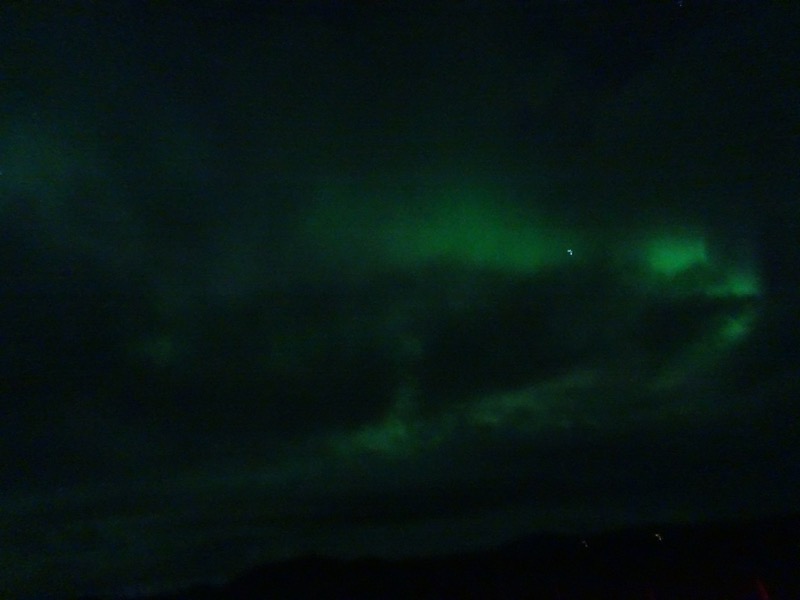 I had to include this – we drove to a dark space behind the Settlement Centre in town and found others attempting to photograph the aurora too… and would you believe this: it’s pitch black, the sky is green and a Chinese couple are here and the guy is trying to photograph his partner in front of the northern lights.
I had to include this – we drove to a dark space behind the Settlement Centre in town and found others attempting to photograph the aurora too… and would you believe this: it’s pitch black, the sky is green and a Chinese couple are here and the guy is trying to photograph his partner in front of the northern lights.
*rolls eyes so skyward, I think I am going to fall over*
ALL the portraits – WHY? Later on – just before we were getting ready for bed, we stuck our head outside the door and saw what looked like lights… so we quickly got dressed and ran outside. As I said, I didn’t have a tripod, so these are 8 second, handheld exposures… but I didn’t really care too much about the photos – the experience was the important bit. I took a handful of photos and then stuffed the camera in my pocked to just watch. We’ve had so much cloud cover, rain and bad weather that we didn’t think we were going to see the aurorae at all.
Later on – just before we were getting ready for bed, we stuck our head outside the door and saw what looked like lights… so we quickly got dressed and ran outside. As I said, I didn’t have a tripod, so these are 8 second, handheld exposures… but I didn’t really care too much about the photos – the experience was the important bit. I took a handful of photos and then stuffed the camera in my pocked to just watch. We’ve had so much cloud cover, rain and bad weather that we didn’t think we were going to see the aurorae at all.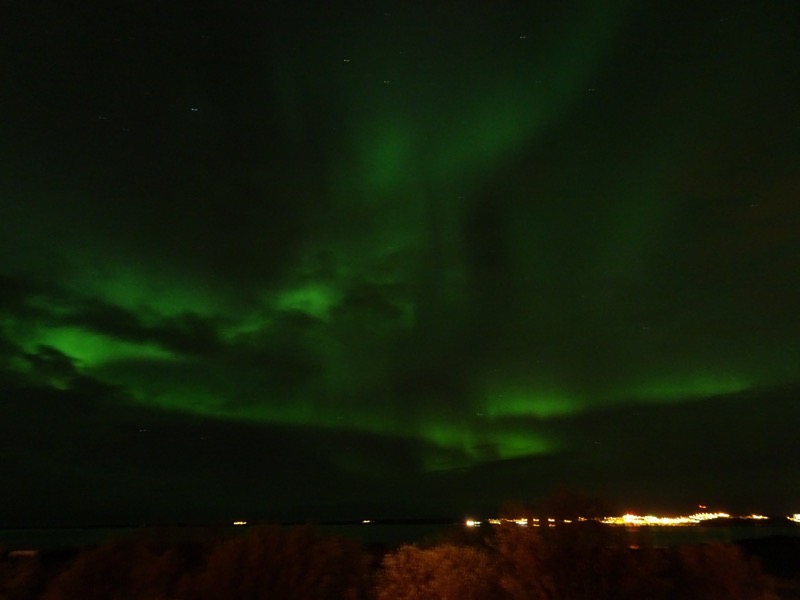
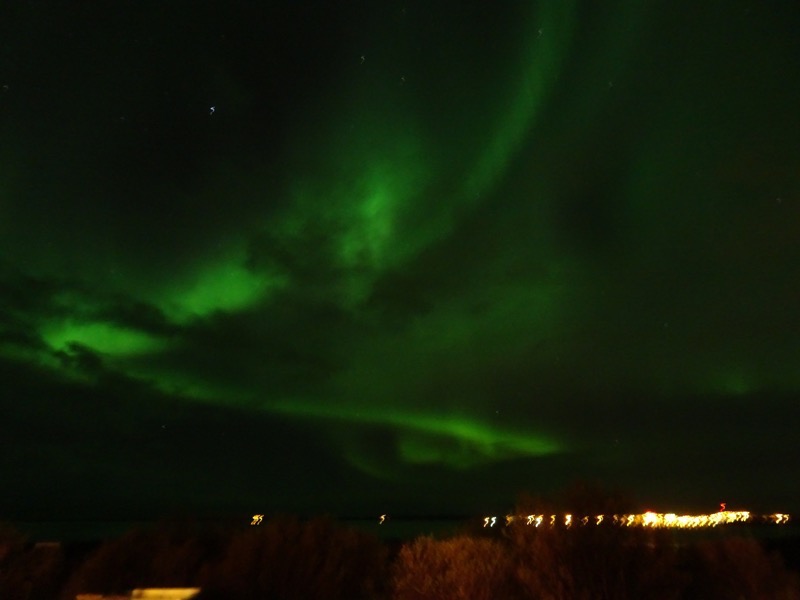
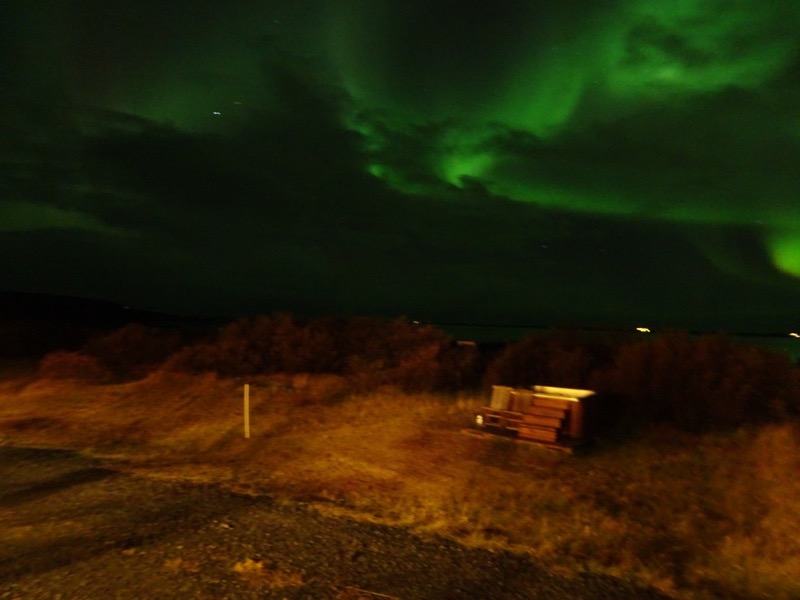
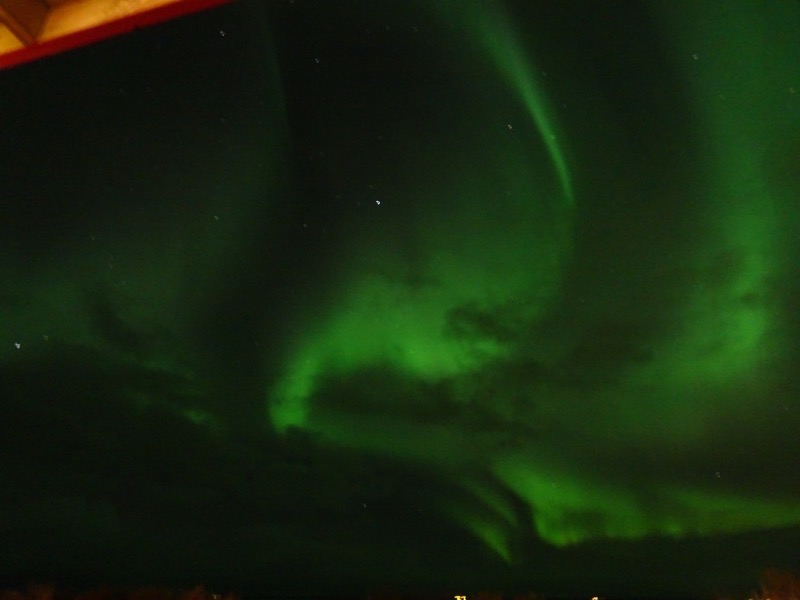
 Stunning! And on that note – bed time.
Stunning! And on that note – bed time.
